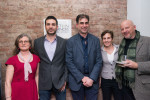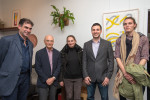 Studio Lecture – The King’s Kitchen Garden of Versailles
Studio Lecture – The King’s Kitchen Garden of Versailles
On Sunday, February 25, Antoine Jacobsohn, the Director of the King’s Kitchen Garden in Versailles, presented an illuminating in-studio lecture (co-organized by the Horticultural Society of New York and the French Heritage Society) on the ground’s cultural and historical significance, how it developed into a plentiful kitchen garden that hosted a variety of edibles, the challenges he has faced in his tenure, and how he plans to develop the ground’s farming practices and estate infrastructure as it looks towards the future.
Antoine began the presentation by touching on the relevance of the location of the garden on its resulting soil type and hydrology, having been built on top of low-lying swampland with the fill material during the creation of le Bassin des Suisses. Jean-Baptiste La Quintinie, the King’s gardener who oversaw the design and implementation of the 22-acre kitchen garden, also developed a series of farming methods to stimulate growth and promote early harvests. One of the more notable themes brought up throughout the presentation was La Quintinie’s commitment to teaching. From the King’s Kitchen Garden’s inception, it was devised to be a public educational institution, which is a tradition still continued today as the site of the National School of Landscape Architecture.
The modern-day garden, Antoine outlined, hosts a lesser quantity of food-plant varieties from that from Louis XIV’s reign. However, there are still currently between 300 and 400 vegetable varieties and approximately 460 fruit varieties being grown today, including 160 varieties of apple, 140 varieties of pear, approximately 35 plums, 24 figs and an assortment of red fruits –– one being the Fragaria monophylla, also known as the One-Leaved Strawberry, or Strawberry of Versailles. To sustain the educational programs, farming practices and maintenance of the grounds, it helps that fruits and vegetables can be bought on site by the visitors and sold to few local restaurants looking for organic produce.
The presentation quickly moved to the challenges faced today by such a historical garden, such as erosion of infrastructure, leaking pipes, crumbling walls and so on. To combat this, a new campaign of restoration is on its way to aid the preservation of the garden as well as an effort to get this site even more involved with the general public, thanks to some more community-focused events such as art festivals. To watch the entire presentation, see video below or click here, or visit our Facebook page.








